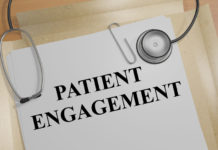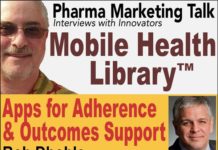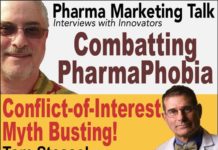Stop the Mobile Insanity! New Strategies for Pharma in the mHealth Market
Check Out Business Podcasts at Blog Talk Radio with Pharmaguy on BlogTalkRadio
You can also visit this Pharma Marketing Talk Segment Page and listen to the archived audio podcast. This show and ALL Pharma Marketing Talk shows are available as podcasts via PMT on iTunes (FREE!).
Background
Leading Pharma companies try hard, but most of them fail, to have a significant impact on the mHealth app market. Some Pharma companies have published more than 100 apps available for iOS and Android, but have generated only limited downloads and usage.
This is one of the results of a research2guidance report “Pharma App Market Benchmarking 2014” released in October 2014.
On average, each of the leading Pharma companies has 65 apps in the Apple App Store and Google Play. In comparison a typical mHealth app publisher, releases just 1-2 mHealth apps.
With all these apps published, Pharma companies have created only little reach within the smartphone/tablet app user base. In fact, the leading Pharma companies have been able to generate 6.6m downloads since 2008 and have less than 1m active users. Given their position in the healthcare market, their app publishing efforts and the performance of some garage-type mHealth app publishers, this performance cannot make any Pharma company happy.
The app publishing activities of Pharma companies differ not only in size and reach, but also which app categories (e.g. reference, fitness, medical condition management) they focus on and to which degree they target private and professional users.
The Pharma app publishers can be clustered into three groups: Niche players, the Still Trying ones without considerable impact and the ones who have already had First Success.

- Niche: Niche players like Roche or Bristol-Myers Squibb use apps to support their core products. They have a higher share of apps that target healthcare professionals and which sometimes require doctor’s identification. Their portfolio size and reach is below average. The higher share of apps that target professionals might be an explanation for the lower reach. Professional target groups are usually smaller compared to private app user groups. Examples of private users they target include women, health enthusiasts or diabetics, all of which represent very large potential user groups.
- First Success: This group represents Pharma companies with a large app portfolio that has gained above average download numbers. The majority of apps target the mass market of private users. The main reason why this group of Pharma companies stands out is because one or two of their apps have a reach of hundreds thousands or even more downloads. For example, 93% of Merck’s app portfolio reach comes from three apps. If it was not for these three apps, Merck’s app portfolio performance would be disappointing.
- Still Trying: This group includes companies like Bayer Healthcare or Novartis. They are very active in terms of the number of apps which target large private user segments. Despite this mass market orientation of their app portfolio, their reach in the app market has remained low and below average. In contrast to the “First Success” players, they have not managed to bring to the market any comparably successful app. 22% of Novartis downloads belong to the top 3 apps.
Questions/Topics of Discussion
- Please review for us research2guidance’s studies on successful mhealth app publishers.
- What differentiates successful publishers from the less successful ones: What works? What doesn’t work?
- What sets them apart in terms of platform choice, experience, tool usage, API usage, size of app portfolio, etc.
- Is it a good strategy for pharma to develop and publish the next 700 apps in the next five years? What other roles might help Pharma increase their return on investment in the app market?
- Tell us about the 2015 mHealth App Developer Economics Study and who should participate.
Guest Bio
 Ralf-Gordon Jahns has been a strategy consultant in the telco industry for 15 years before he founded research2guidance in 2010. Since then he concentrates on the mobile health and app market. He is a publisher of more than 20 mHealth app market report and consults healthcare companies to develop a successful mHealth business.
Ralf-Gordon Jahns has been a strategy consultant in the telco industry for 15 years before he founded research2guidance in 2010. Since then he concentrates on the mobile health and app market. He is a publisher of more than 20 mHealth app market report and consults healthcare companies to develop a successful mHealth business.









![6 Digital Tools at the Center of Healthcare Digitalization [INFOGRAPHIC]](http://ec2-54-175-84-28.compute-1.amazonaws.com/pharma-mkting.com/wp-content/uploads/2021/04/6DigitalTools_600px-100x70.jpg)




